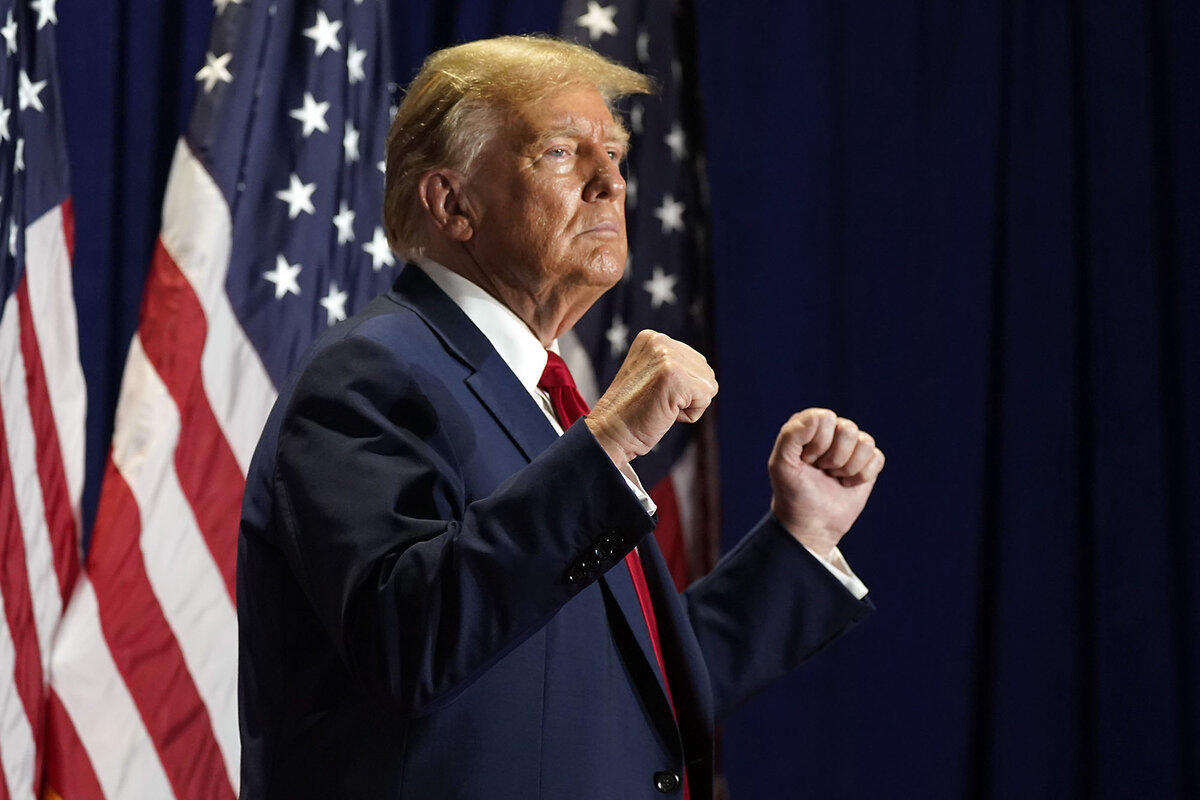Supreme CourtтАЩs ruling keeps Trump on state ballots. Then what?
Loading...
Former President Donald TrumpтАЩs name will stay on the Colorado primary ballot.┬а
The Supreme Court on Monday ruled the state cannot strike him from its list of┬аpresidential candidates on grounds he engaged in insurrection by trying to overturn┬аthe 2020 election.
For all practical purposes, the unanimous ruling ends state-by-state attempts to rule┬аMr. Trump ineligible for the White House under a long-dormant clause of the 14th┬аAmendment that bars insurrectionists from public office.
Why We Wrote This
The U.S. Supreme Court moved unanimously in deciding that states canтАЩt kick Donald Trump off ballots тАУ and in effect left voters to decide whether the former presidentтАЩs 2020 election moves are disqualifying.
But some legal experts say that the decision left important aspects of the issue┬аunresolved as to how they apply to politics today. In particular, they say, it did not┬аclarify whether or how Mr. TrumpтАЩs eligibility to hold office could still be┬аchallenged under the 14th Amendment if he wins.
тАЬThey didnтАЩt say it wasnтАЩt an insurrection, he didnтАЩt engage in it, it doesnтАЩt apply to┬аthe president тАУ those things that would have clearly resolved it,тАЭ says Gerard┬аMagliocca, professor at the Indiana University School of Law.
Ruling lands one day before state primaries
The high court justices fast-tracked their consideration of the Colorado case, Trump v.┬аAnderson. They released their opinion one day before Super Tuesday, when┬аColorado and a number of states hold their primaries.
The case stemmed from a challenge brought by a number of Colorado voters who┬аasked the state to block Mr. Trump from the primary ballot under the 14th┬аAmendmentтАЩs Section 3. That clause bars from public office those who have taken an oath to support the Constitution and then engaged in insurrection or rebellion тАЬagainst the same.тАЭ
The Colorado Supreme Court eventually held that Section 3 did apply to the┬аformer president тАУ and that he had engaged in insurrection against the United┬аStates.
Mr. Trump then asked the U.S. Supreme Court to take up the case. One of the primary┬аarguments his lawyers made was that Section 3 does not mention the presidency,┬аand so does not apply to it. They also argued that Mr. Trump did not engage in insurrection.┬аMondayтАЩs ruling was silent on both of these questions.
The per curiam, or unanimous, opinion held that states can indeed disqualify state officials they┬аdeem insurrectionist. But тАЬstates have no power under the Constitution to enforce┬аSection 3 with respect to federal offices, especially the Presidency,тАЭ the opinion┬аsaid.
State enforcement of Section 3 could result in a тАЬpatchworkтАЭ situation, with an┬аevolving electoral map that could dramatically change the behavior of voters,┬аparties, and electoral results, according to the opinion.
тАЬNothing in the Constitution requires that we endure such chaos,тАЭ the opinion held.
тАЬPer curiamтАЭ means, specifically, a unanimous ruling meant to reflect the opinion of the┬аcourt as a whole and not the ideas or work of a single judicial author. In┬аessence, the decision was 9-0.
That unanimity on the central point of the case is the biggest takeaway from todayтАЩs court┬аaction, says Josh Blackman, professor at the South Texas College of Law in Houston.┬атАЬAll nine justices agree this was a terrible idea,тАЭ he says.
What does тАЬunanimousтАЭ mean?
But some unanimous opinions are more unanimous than others, says Alison┬аLaCroix, professor at the University of Chicago Law School.
Indeed, all nine justices┬аagreed that Mr. Trump should appear on the Colorado ballot тАУ but four of them, in┬аseparate opinions, said the other five had gone beyond what was necessary in discussing┬аlimitations on how the insurrection clause might be enforced.
тАЬItтАЩs a unanimous opinion by any meaningful definition of that term, but it is not┬аthe court speaking with one voice, and that is significant,тАЭ says Professor LaCroix. The per curiam decision said that the responsibility for enforcing Section 3 against┬аfederal officeholders and candidates rests with Congress, not the states.
Specifically, it said that the disqualification clause at the national level can be┬аenforced only through federal legislation, not through a federal court challenge or other nonlegislative action by Congress.
Justice Amy Coney Barrett, a Trump appointee, said in a brief concurring opinion┬аthat the majority had gone too far in discussing the тАЬcomplicated questionтАЭ of┬аcongressional enforcement.
The liberal trio of Justices Sonya Sotomayor, Elena Kagan, and Ketanji Brown Jackson were sharper in their criticism, saying that the per curiam┬аopinion тАЬshuts the doorтАЭ on other means of federal enforcement.┬атАЬWe cannot join an opinion that decides momentous and difficult issues┬аunnecessarily,тАЭ they wrote.
One problem is that simply saying Congress needs to pass legislation to enforce┬аSection 3 is vague, and it does not define what counts as legislation, says Professor Magliocca.
Does existing legislation, such as the Electoral Count Reform Act, count? Would┬аcongressional action in a joint session be ruled out?
тАЬIn effect, there are these sloppy statements in the majority opinion that donтАЩt need┬аto be there, and itтАЩs confusing,тАЭ he says. тАЬI donтАЩt think the four understand what the┬аfive are trying to say.тАЭ
Some experts worry about potential turmoil┬аin the case of a Trump victory. What would happen if Democrats in Congress object to the counting of Electoral College votes for Mr. Trump, saying he is constitutionally ineligible for office?
After all, in MondayтАЩs ruling the Supreme Court did not rule that Section 3 of the┬а14th Amendment did not apply to Mr. Trump. In its ruling, the Colorado Supreme Court held that Mr. Trump engaged in┬аinsurrection when he summoned supporters to Washington in advance of Jan. 6, 2021, and encouraged them to disrupt the congressional certification of President Joe┬аBidenтАЩs Electoral College votes.
MondayтАЩs per curiam Supreme Court opinion was silent on the matter.
тАЬThe court decided that [Mr. TrumpтАЩs] innocence [or guilt] was not relevant,тАЭ says Mark Graber, professor at the University of Maryland School of Law.




